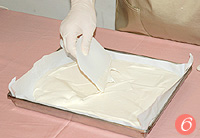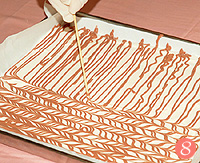 Ingredients Ingredients  (Pic 1) (Pic 1) |
 290 ml water 290 ml water
 35g (1.2 oz) inverted syrup 35g (1.2 oz) inverted syrup
 90g (3.2 oz) granulated sugar 90g (3.2 oz) granulated sugar
 1g (less than 1/4 teaspoon) salt 1g (less than 1/4 teaspoon) salt
 100g (3.5 oz) cake flour and 100g (3.5 oz) all-purpose flour, mixed and sifted 100g (3.5 oz) cake flour and 100g (3.5 oz) all-purpose flour, mixed and sifted
 45g (1.6 oz) concentrated whey protein powder 45g (1.6 oz) concentrated whey protein powder
 6g (0.2 oz) baking powder 6g (0.2 oz) baking powder
 25g (0.9 oz) SP cake emulsifier 25g (0.9 oz) SP cake emulsifier
 1/2 teaspoon vanilla powder 1/2 teaspoon vanilla powder
 80g (2.8 oz) vegetable oil 80g (2.8 oz) vegetable oil
 1/2 teaspoon cocoa powder, mixed with 1/2 tsp hot water 1/2 teaspoon cocoa powder, mixed with 1/2 tsp hot water
|
| |
|
|
 Butter-cream Filling Butter-cream Filling  |
 150g (5.3 oz) salted butter softened at room temperature (pic 2) 150g (5.3 oz) salted butter softened at room temperature (pic 2)
 150g (5.3 oz) vegetable shortening or 150g (5.3 oz) butter softened at room temperature (pic 3) 150g (5.3 oz) vegetable shortening or 150g (5.3 oz) butter softened at room temperature (pic 3)
 200g (7 oz) powdered sugar, sifted (pic 4) 200g (7 oz) powdered sugar, sifted (pic 4)
|
| |
|
|
 Directions Directions  |
1. Preheat oven to 200ºC (390ºF).
2. Place water in a mixing bowl. Add ingredients in the following order: inverted syrup, granulated sugar, salt, flour, whey protein powder, baking powder, SP cake emulsifier and vanilla powder. |
Beat with electric mixer at low speed until completely blended, then change to high speed to beat until the batter thickens and turns pale and the specific gravity* reaches 0.50 – 0.55, about 10 minutes. (pic 5)
|
|
| |
*Note: It is very helpful for new chefs to calculate specific gravity while making sponge cakes. Specific gravity is the density of batter compared to the density of water. It is a way to see whether batter has been beaten well enough to hold the proper amount of air.
Specific gravity of batter = (the weight of a cup filled with batter – the empty cup) ÷ (the weight of a cup filled with water – the empty cup)
The way to weigh water and batter is as follows:
Weigh an empty flat-bottomed measuring cup and fill it with clear water. Weigh the cup again and pour out the water. Fill the empty cup with batter and weigh it. Be sure not to allow air pockets to form when pouring the batter. Do not clap or slam the filled cup on the table, because it will release the air in the batter and cause the accuracy of the measurement to be lost.
|
3. After the correct specific gravity for the batter has been reached, add vegetable oil and blend well at low speed with an electric mixer. Do not blend for too long. Then, use a rubber spatula to mix the batter more evenly.
|
| |
4. Pour most of the batter into a Swiss roll tin (24 cm × 35 cm × 2 cm) lined with parchment paper or baking liner and keep about 2 tablespoons batter for later use. Spread out the batter in the baking tin evenly and smooth the surface. (pic 6) |
 |
Place leftover 2 tablespoons batter into a plastic bag and snip off a bottom corner. Squeeze the batter to draw parallel lines on the surface of the batter. Then use a skewer to line vertically. A leaf-shaped design will be formed. (pic 7, 8)
|
|
 |
| |
5. Place baking tin in the middle rack of oven and bake for about 15 to 20 minutes.
|
6. While the cake is baking, make the butter-cream filling: Blend butter, vegetable shortening and powdered sugar in a mixing bowl with an electric mixer at low speed until mixed, then change to medium speed to beat until the cream turns pale, fluffy and feathery. (pic 9)
|
|
7. When cake is done, remove tin from oven. Lightly drop the tin twice on a hard surface, then place it on a wire rack to cool until lukewarm. (pic 10)
Turn cake onto a sheet of greaseproof paper larger than the cake and remove baking liner. (pic 11)
Spread the surface with a thin layer of butter cream. Use baker's spatula knife to lightly score three lines, about 1 cm apart on the surface of the side near you. Do not score too deeply so as not to cut through cake. (pic 12) |
|
|
| |
| |
Place a rolling pin behind the greaseproof paper to press and roll cake forward (refer to pic 13, 14 and the demonstration film.)
After rolling, keep Swiss roll with the greaseproof paper wrapped for about 10 minutes to set shape. (pic. 15) Then remove paper, slice cake and serve.
|
|
|
|
|
 Notes Notes  |
1. If inverted syrup is not available, corn syrup or honey may be used instead.
2. Whey protein powder is a by-product of milk that can used as an egg substitute. It is an important ingredient in making egg-free sponge cakes. Whey protein powder can be categorized into different types based on the percentage of protein it contains. The recommended variety isWhey protein concentrate-oragel HG80 from the French company Armor Proteins, which contains more than 80% of protein and can ensure greater success in baking sponge cake.
3. SP cake emulsifier is a batter-aerating agent and emulsifier for cakes that increases the fineness and softness of a baked cake’s texture.
4. If vanilla extract is used, instead of vanilla powder, it should be added after the batter has reached the correct specific gravity in step 3. After adding extract, beat batter at medium speed for about 10 seconds. Then add the vegetable oil and beat at low speed. If vanilla extract is added during the first mixing process, its scent will evaporate due to the presence of the other ingredients. If vanilla powder is used, however, no such effect will occur.
5. Granulated sugar can’t be used in place of powdered sugar in making butter cream, because the result will be different.
6. The butter-cream filling can be replaced by whipped non-dairy cream or jam.
|
| |
|
|
|